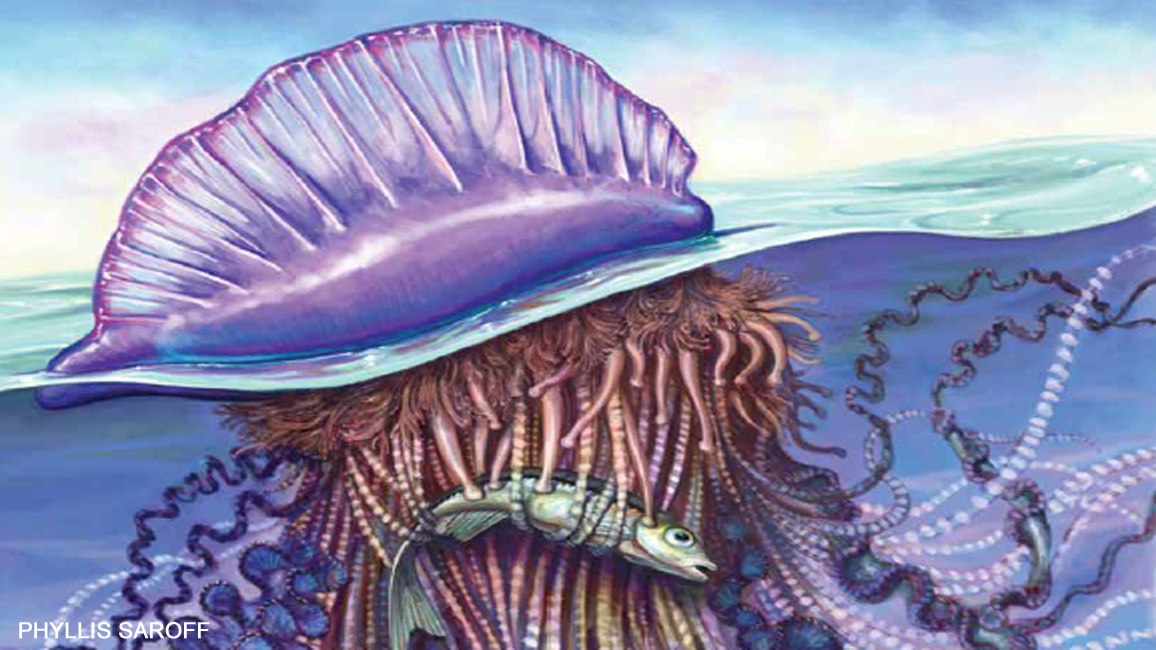
Meet the Man-of-War
By Kathy KrankingIt has a weird name, a bubble body, and colorful tentacles. But what exactly is it?

You’re looking at a close-up view of a Portuguese (por-chuh-GEEZ) man-of-war. Those pretty tentacles may look like pearl necklaces and ruffled ribbons. But they’re actually weapons that can be deadly.
Now look at the top right photo showing the whole man-of-war. Floating in the ocean with its tentacles trailing below, a man-of-war is a strange and beautiful sight. You might be surprised to learn that it’s not a jellyfish, though it kind of looks like one. It’s really a siphonophore (sye-FON-uh-for), a jellyfish cousin. And here’s another surprise: Like all siphonophores, a man-of-war isn’t just one animal—it’s a colony of many animals that work together as one!
The separate animals are called polyps (PAH-lups). There are four different kinds. The first is the float: the 6-inch-tall, gas-filled “bag” that stays above the water. It can be blue, purple, or pink and acts as a sail while the man-of-war drifts along the warm oceans where it lives.
The tentacles are the second kind of polyps. They catch food and defend the man-of-war from enemies. The third kind of polyps eat and digest the food. And the fourth kind make eggs or sperm and allow the man-of-war to reproduce.
All the different kinds of polyps depend on each other. They wouldn’t be able to survive on their own.
VIDEO: WATCH A MAN-OF-WAR IN ACTION!

PRETTY POISON
The man-of-war’s tentacles usually grow to be about 30 feet long, but some can be as long as 165 feet. That’s half the length of a football field! The tentacles are a treacherous trap for prey. They’re covered with thousands of microscopic stinging cells. Inside each cell is a tiny dart loaded with venom. The venom can paralyze or kill small fish and other prey.
As it drifts along, the man-of-war uses its tentacles to go “fishing.” If an unlucky fish brushes up against the trailing tentacles, the darts shoot out. They stab into the fish and inject it with venom. Then the tentacles pull the helpless fish up toward the bottom of the float (see drawing above).
That’s where the eating polyps of the colony come in. They’re tiny, bag-like “stomachs” with even tinier “mouths.” They ooze stuff that dissolves the fish’s body. Then they digest it, spreading the food to the whole colony.
The man-of-war’s stingers aren’t just for catching food. They also keep the man-of-war safe from most enemies. But ocean sunfish, some kinds of sea turtles, and a few other creatures will slurp up a man-of-war without thinking twice. The stingers don’t bother them at all!
WASHED UP
Though the man-of-war can’t swim, it can deflate its sail. That allows it to sink beneath the surface of the water. It might do this to protect itself during storms or if it begins to dry out in sunny weather. Dipping below the waves can also help keep it safe from gulls or other birds that may attack it.
But often, the man-of-war is no match for strong winds and waves. It’s a common sight to see a man-of-war—or hundreds of them together—washed up onto a beach! Even in this condition, the man-of-war’s stinging cells can still fire if touched. Though the stings are not usually deadly to people, they can be very, very painful. Dead or alive, a man-of-war is not to be messed with!
So now you know all about the mighty man-of-war—from the top of its crest to the tips of its tentacles.
















